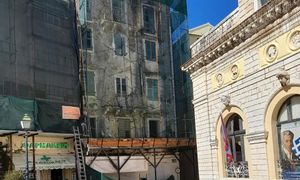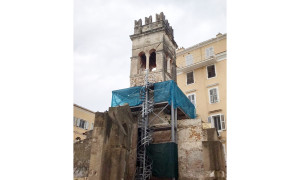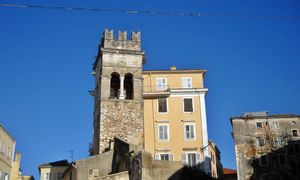Corfu welcomes the summer with a dazzling ΄new΄ Annunziata bell tower!

CORFU. The restoration began about 10 years ago, while the Save Annunziata movement significantly contributed to raising public awareness.
In any other part of the Western world, the enthusiastic reactions to the restoration of a bell tower would seem excessive. In Corfu, however, where monuments are collapsing, they are to be expected!
The restoration began about 10 years ago, while the Save Annunziata movement, which started its activities in 2009, significantly contributed to raising public awareness. After 15 years, as it emphatically points out on social media, 'the struggle has finally been vindicated.'
The project for the restoration of the bell tower of the former Catholic Holy Church of the Annunciation 'Annunziata' initially started with resources from the Public Investment Programme and was subsequently included on 11-08-2020 in the Business Programme 'Ionian Islands 2014-2020' with a budget of 312,976 euros (plus VAT) and implemented by the Directorate for the Restoration of Byzantine and Post-Byzantine Monuments and the Corfu Ephorate of Antiquities.
The aim of the project was for the important, preserved monument to be restored and made functional for the residents of the island and its numerous visitors, as well as to stop posing a serious threat to the physical safety of passersby.
However, the usual 'curse' of public works in Greece sent the project into adventures with contractors, while the Corfiots had become accustomed to the sight of the beautiful but dilapidated bell tower, which was covered with scaffolding and burlap. The project's scope included reinforcing the walls, pointing, stitching cracks with stone keys, local rebuilding of stonework sections, installing new stainless steel ties, strengthening domes, plastering, repairing the entrance staircase and bell tower, constructing floors, frames, an internal staircase, repairing and constructing new floors, restoring the bell suspension system, arranging the excavated burial site, and putting up signs.
The largest and most visible work of the restoration and repair of the bell tower has finally been completed, and today the iron scaffolding was removed with a crane. Although the bell tower is ready, some work remains to be done on the floor and the murals.

The result, however, has rewarded the Corfiots – as well as the visitors – since its appearance has been radically renewed. Even more important is the fact that its stability was restored, as neglect had made the risk of collapse evident at any moment.
German bombing in 1943
The bell tower was part of a church dedicated to the Annunciation of the Virgin Mary and Saint Lucia. It was known to the Corfiots as the Catholic Church of Lontsiada.
It was built at the end of the 14th century by the Neapolitan captain Petro Capece and dedicated to the Annunciation of the Virgin Mary since March 25th coincided with the founding date of the Venetian Republic.
Two centuries later, in 1571, the remains of Christian fighters from various European regions, who fought in the Battle of Lepanto, were buried there inside the church. This battle is considered the first significant blow against the Ottoman Empire. The Battle of Lepanto, between the fleets of the Holy League – composed of the fleets of Venice, Spain, Naples, Sicily, Genoa, and Malta – against the hitherto undefeated fleet of the Ottomans, was one of the most significant events in world history.
Opposite, in temple-owned premises, the battle wounded were accommodated, including the Spanish national poet Miguel de Cervantes.
In this building, some of the brave Corfiot fighters who were killed in the battle were buried. 300 Corfiot fighters participated with 4 ships led by captains Petros Bouas, Christoforos Kontokalis, Georgios Kokkinis, and Stylianos Halikiopoulos. There is even an inscription preserved by the Catholic Archdiocese of Corfu.
Today, the church no longer exists. It was first destroyed by German incendiary bombings on September 14, 1943, and later demolished during the mayorship of Stamatis Desyllas in 1953 - just like the Municipal Theatre...
CHRISTINA GEREKOU
Photos: Stamatis Katapodis











